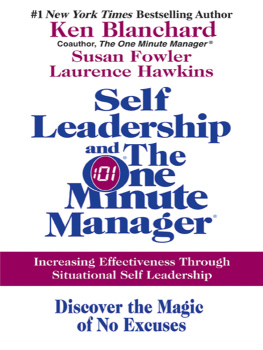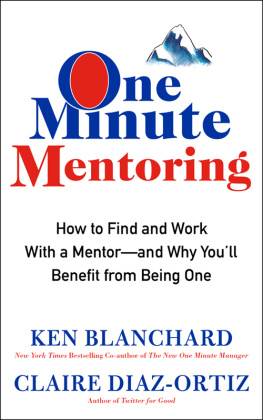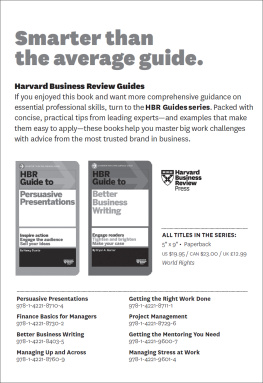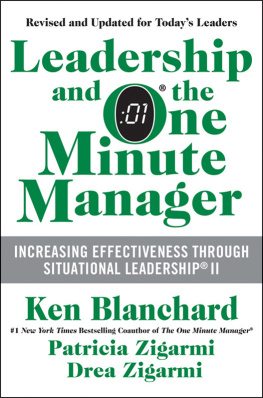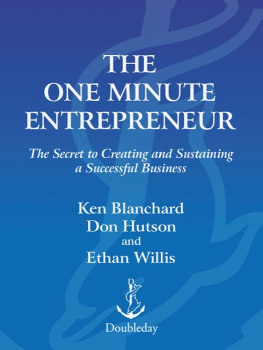
The New One Minute Managers symbol is intended to remind each of us to take a minute out of our day to look into the faces of the people we lead and manage. And to realize that they are our most important resources.

Contents
Guide
The world has changed since the publication of the original One Minute Manager. Today, organizations must respond faster, with fewer resources, to keep up with ever-changing technology and globalization.
To help you lead, manage, and succeed in this changing world, were happy to offer you The New One Minute Manager.
Since the underlying principles in the now-classic story remain the sameand have helped so many millions of people around the worlda good deal of this story also remains the same.
But, just as the world has changed, so has the One Minute Manager. He has a new, more collaborative approach to leading and motivating people.
When he first started teaching his Three Secrets, top-down leadership was a way of life.
These days effective leadership is more of a side-by-side relationship. Youll see that reflected in The New One Minute Manager.
Today, people look for more fulfillment in their work and their lives. They want to feel engaged and make a meaningful contribution. Theyre less willing to trade time on the job to satisfy needs outside of work.
The New One Minute Manager understands this, and treats people accordinglyknowing they are key contributors to the organizations success. He realizes that attracting and keeping talent is a top priority.
The key is how he uses his new approach.
As the ancient sage Confucius advises, The essence of knowledge is, having it, to use it.
We trust youll consider using the Three Secrets youll discover in The New One Minute Manager to succeed in your changing worldnot only with colleagues and associates at work, but also with your family and friends.
If you do, were confident that you and the people you work and live with will enjoy healthier, happier, and more productive lives.
Ken Blanchard, PhD
Spencer Johnson, MD
O NCE there was a bright young man who was looking for a special kind of manager who could lead and manage in todays changing world.
He wanted to find one who encouraged people to balance their work and their life, so that each became more meaningful and enjoyable.
He wanted to work for one and he wanted to become one.
His search had taken him over many years to the far corners of the world.
He had been in small towns and in the capitals of powerful nations.
He had spoken with many managers who were trying to deal with a rapidly changing world: executives and entrepreneurs, government administrators and military personnel, university presidents and foundation directors; with managers of shops and stores, of restaurants, banks, and hotels; with men and womenyoung and old.
He had gone into every kind of office, large and small, luxurious and sparse, with windows and without.
He was beginning to see the full spectrum of how people manage people.
But he wasnt always pleased with what he saw.
He had seen many tough managers whose organizations seemed to win while the people working there lost.
Some thought they were good managers. Many thought otherwise.
As the young man sat in each of these tough peoples offices, he asked, What kind of a manager would you say you are?
Their answers varied only slightly.
Im a bottom-line managerI keep on top of the situation, he was told. Hard-nosed. Realistic. Profit-minded.
They said they had always managed that way and saw no reason to change.
He heard the pride in their voices and their interest in results.
The young man also met many nice managers whose people seemed to win while their organizations lost.
Some of the people who reported to them thought they were good managers.
Those to whom they reported had their doubts.
As the young man sat and listened to these nice people answer the same question, he heard:
Im a participative manager. Supportive. Considerate. Humanistic.
They also said they had always managed that way and saw no reason to change.
He heard the pride in their voices and their interest in people.
But he was disturbed.
It was as though most managers in the world were still managing the way they had always done and were primarily interested either in results or in people.
Managers who were interested in results often seemed to be labeled autocratic, while the ones interested in people were often labeled democratic.
The young man thought each of these typesthe tough autocrat and the nice democratwas only partially effective. Its like being half a manager, he thought.
He returned home tired and discouraged.
He might have given up his search long ago, but he had one great advantage. He knew exactly what he was looking for.
In these changing times, he thought, the most effective managers manage themselves and the people they work with so that both the people and the organization profit from their presence.
The young man had looked everywhere for an effective manager but had found only a few. The few he did find would not share their secrets with him. He began to think maybe he would never find what he was looking for.
Then he began hearing marvelous stories about a special manager who lived, surprisingly, in a nearby town. He heard that people liked to work for this man and that they produced great results together.
He also heard that when people applied the managers principles to their personal lives, they got great results as well.
He wondered if the stories were really true and, if so, whether this person would be willing to share his secrets with him.
Curious, he phoned the assistant to this special manager to see if he might get an appointment. To his surprise, the assistant put him through to the manager immediately.
The young man asked when he might be able to meet with him, and the manager said, Anytime this week is fine, except Wednesday morning. You pick the time.
The young man was puzzled. What kind of manager had that kind of time available? But he was fascinated as well, and went to see him.
W HEN the young man arrived at the Managers office, he found him looking out the window. The Manager turned and invited him to sit down. What can I do for you?
Ive heard great things about you and would like to know more about the way you manage.
Well, were using our proven methods in several new ways to deal with all the changes that are happening, but we can get to that later. Lets begin with the basics.
We used to be a top-down managed company, which worked in its time. But today that structure is too slow. It doesnt inspire people and it stifles innovation. Customers demand quicker service and better products, so we need everyone to contribute their talent. The brainpower isnt only in the executive officeit can be found throughout the organization.
Since speed is a currency of success now, leading with collaboration is far more effective than the old command-and-control system.
How do you lead with collaboration?
I meet with our team once a week on Wednesday morningsthats why I couldnt meet with you then. At those meetings I listen as our group reviews and analyzes what they achieved the previous week, the problems they had, what remains to be accomplished, and their plans and strategies to get those things done.
Next page

